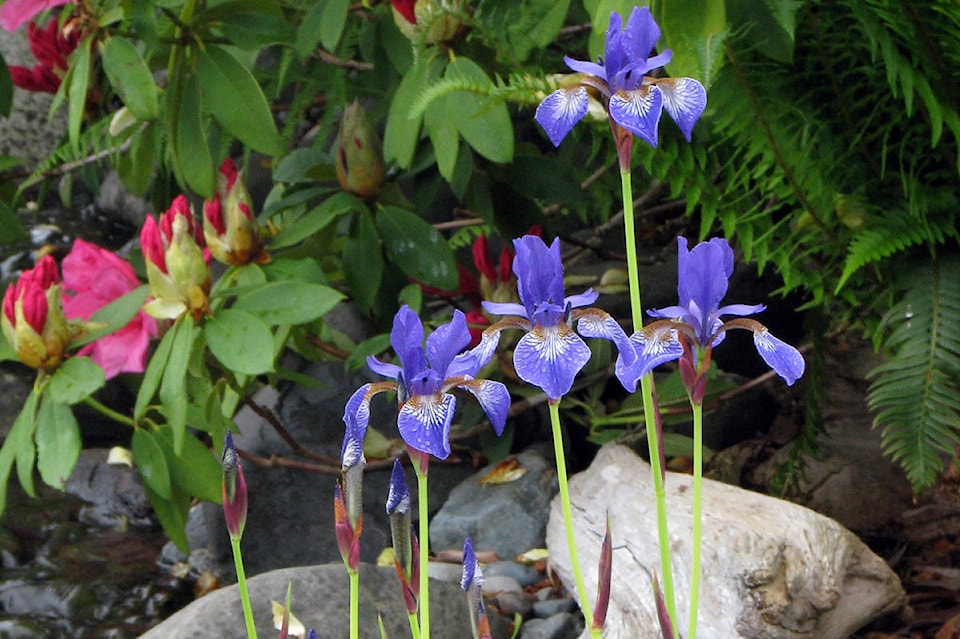| When the iris is in blossom it's time to plant your peppers - so says the time-tested science of phenology. Photo by Leslie Cox |
Enthusiasm is a wonderful motivator but it can certainly bite the gardener in the butt.
Case in point: a sunny stretch of weather enticed us out into our garden to start the pruning chores. By the third day I had had enough of taming the gargantuan rhododendron macrophyllum down to size and switched over to my island bed for a dose of “spring surprise.”
There were primula leaf tips poking through the leaf mulch covering my beds so I figured it was time to pull the leaf mulch off to thwart any slugs hiding underneath. Those pests love fresh young greens.
It was heartening to see tiny red dots of my wood anemone (Anemone nemerosa ‘Robinsoniana’) against the dark earth. Right beside, fresh nubs of growth were emerging from the centre of my Panda Face wild ginger (Asarum maximum). Won’t be long before the distinct panda-coloured flowers would be showing. Not to be outdone, there were also tiny stems of columbine (Aquilegia vulgaria ‘Woodside Gold’) topped with swirls of their first leaves broadcasting early colours of gold and maroon. Spring is definitely coming.
Not!
That very night, the temperatures dipped down to -5.5C in our garden. Thankfully, the columbines and native wood anemone do not get too upset about such chilly conditions. Or the primulas. But my panda ginger is not as hardy. I should not have uncovered it just yet.
Curses. I have set it back a few weeks. Again. I really must learn to curb my enthusiasm… at least until I spot the signals from nature for the proper time to do certain chores. For instance, when the forsythia is in bloom you should prune your roses, fertilize the lawn, plus sow pea and lettuce seeds.
It may sound rather corny, but there is a lot of truth in the science of phenology. In fact, these are the timing tools our ancestors would have used. (I remember my granny telling me the forsythia one.)
Since forsythia was not established in North America until later, early settlers would have watched for crabgrass germinating to time pruning their apple trees.
But shadbush (Amelanchier) is a native plant and a useful indicator it was time to plant potatoes when this shrub came into bloom.
Did you know when crab apples are beginning to break bud, you should keep your eyes peeled for tent caterpillars? This is when these pests start to appear. And when those nasty dandelion weeds start blooming, you should get busy sowing beets, carrots, and spinach in the vegetable garden.
When oak leaves are the size of a squirrel’s ear and the petals are dropping from your apple trees, they are telling you it is high time the corn was planted. Transplant your eggplant and pepper seedlings into the garden when the irises are in bloom.
Start watching for young hungry grasshoppers when the purple lilacs come into flower. This is when the eggs begin to hatch. And the final fading of their blossoms is the tell-tale sign you should be planting cucumbers and squash while blossoms on peonies means it is warm enough to plant melons.
All of these phenology indicators are useful timing tools for various garden chores. Scientists are also finding them useful in tracking changes in climate. A report published in 2000 stated aspen poplar trees (Populus tremuloides) in the Edmonton area are now coming into bloom 26 days earlier than they did a century ago. Not quite so alarming, shadbushes are blooming three days earlier in the same region while chokecherries are five days earlier than what used to be normal timing.
Bottom line: we should all set our watches by Mother Nature.
Leslie Cox co-owns Growing Concern Cottage Garden in Black Creek. Her website is at www.duchessofdirt.ca and her column appears every second Thursday in the Record.
